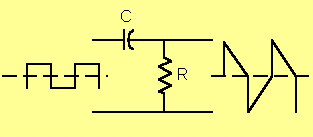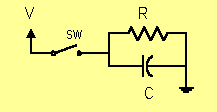Choosing Capacitors
By Jorge J. Ramirez
In any electrical design, when choosing
a capacitor its size and shape are as important as its electrical
characteristics. The designer should check for correct lead spacing,
maximum working voltage, and polarization.
- Radial capacitors have both ends coming out of the same end.
- Axial capacitors have the same shape as resistors with a wire coming out of each end.
- Electrolytic and tantalum capacitors are polarized
and must be fitted the correct way.
Typical capacitors applications are:
-
Remove power supply spikes ( place 0.01 to 0.1uf across power supply pins of digital ICs).
-
Smooth out rectified AC voltage into steady DC voltage.
-
Block DC signal while passing AC signal.
-
Filter out unwanted portions of a fluctuating signal.
-
Bypass AC signal around a circuit or to ground.
-
Use with resistor to differentiate a fluctuating signal.
Figure 1. RC differentiator circuit
This circuit is used to create trigger pulses. The RC time constant must be at least 1/10 or less the period of the incoming signal.
-
Use with a resistor to integrate a fluctuating signal.
Figure 2. RC integrator circuit
The RC time constant must be at least 10 times the period of the incoming signal otherwise it will reduce the amplitude of the incoming signal. The circuit becomes a low pass filter blocking high frequencies.
-
Use in timing applications.
Figure 3. RC basic timing circuit
The circuit will charge quickly C and then it will discharge slowly through R at a time given by the time constant RC.
-
Store a charge to keep a transistor turned off or on.
|
TYPE |
RANGE |
TOLERANCE |
STABILITY |
APPLICATIONS |
|
Ceramic low loss |
5pf to 10nf |
10% |
Good |
Coupling and decoupling |
|
Ceramic high k |
5pf to 1uf |
20% |
Fair |
Coupling and decoupling |
|
Ceramic monolithic |
1nf to 47uf |
10% |
Good |
Coupling and decoupling |
|
Electrolytic |
1uf to 100000uf |
50% |
Fair |
LF decoupling and smoothing |
|
Paper |
10nf to 1onf |
10% |
Fair |
Motor start, interference suppression |
|
Polypropylene |
1nf to 100uf |
5% |
Fair |
Noise suppression and motor start |
|
Polyester |
100pf to 2uf |
5% |
Fair |
General purpose, coupling and decoupling |
|
Polystyrene |
50pf to 0.5uf |
1% |
Great |
Timing, tuned circuits, and filters |
|
Silver mica |
5pf to 10nf |
0.5% |
Great |
Tuned circuits and filters |
|
Tantalum |
1uf to 2000uf |
5% |
Great |
LF coupling, decoupling and timing circuits. |


